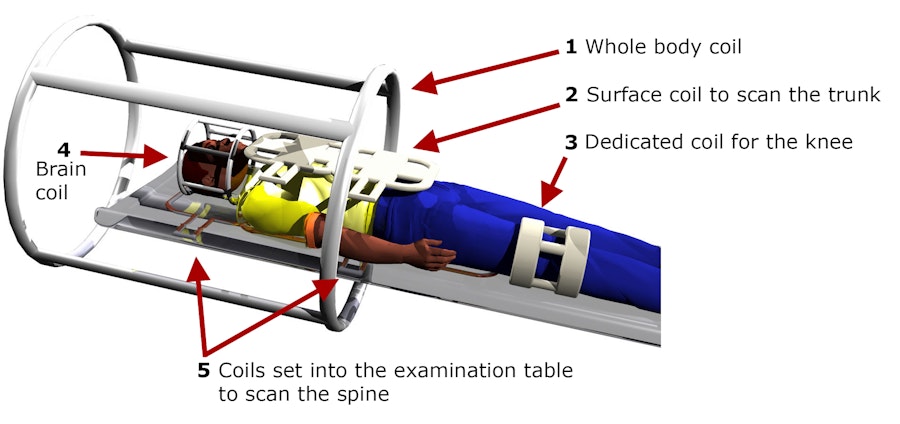Radiofrequency system
Radiofrequency system components
The radiofrequency system includes all the components for transmitting and receiving the radiofrequency waves involved in exciting the nuclei, selecting slices, applying gradients and in signal acquisition.
Coils are a vital component in the performance of the radiofrequency system.

In transmission, the goal is to deliver uniform excitation throughout the scanned volume. On reception, the coils must be sensitive and have the best possible signal to noise ratio.
An MR scanner generally contains a « whole body » coil, located in the cylinder of the machine, uniformly covering the entire scan volume. The sensitive volume of surface coils, being placed in direct contact with the zone of interest, has less depth and is more heterogeneous. However, surface coils offer a better signal to noise ratio and imaging capacity with higher spatial resolution. The homogeneity and sensitive volume of surface coils can be improved by combining them into a phased array. They still have the advantage of a better signal to noise ratio, but at the cost of more complex signal processing.
Quadrature RF coils (circularly polarized coils) consist of at least two coils that are oriented orthogonal to each over (and both are othogonal to B0 axis). They have a better signal to noise ratio than linear RF coils.
Depending on the manufacturers and the type of coil, certain coils can be transmitters, receivers or both.
The radiofrequency channel also comprises analog-digital converters and a spectrometer to receive and analyze the signal.
Optimizing the radiofrequency channel
Optimization of the radiofrequency channel is automated and carried out in several stages prior to an imaging sequence:
- the exact Larmor frequency is set, this being slightly modified by the patient’s presence in the magnetic field
- transmission power is adjusted according to the weight of the patient and the transmit coil, to obtain the desired flip angles
- the receiver gain is adjusted to avoid signal saturation or conversely, weak amplification resulting in a deteriorated signal to noise ratio.
Faraday cage
As the resonance frequency of protons is very close to that of the radio waves used in radio broadcasting and the FM band, the MR device is placed in a Faraday cage to insulate it from external RF signals which could alter the signal. The copper Faraday cage completely encases the MR scanner. Openings through this cage need to be carefully designed to avoid canceling out the shielding effect.
